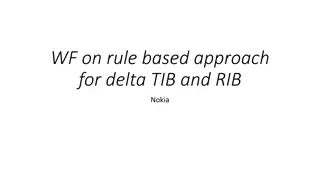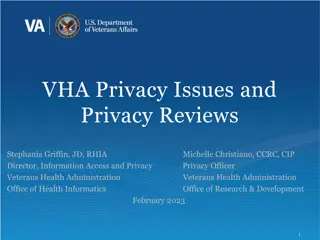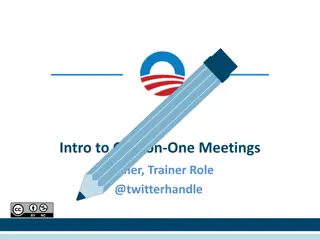Understanding Individually-Based Limitations in Practice
Explore scenarios where individuals are either supported or restricted in their food choices based on their health-related goals. Learn about proactive strategies and intervention techniques used to assist individuals in achieving their objectives while respecting their autonomy and preferences.
Download Presentation

Please find below an Image/Link to download the presentation.
The content on the website is provided AS IS for your information and personal use only. It may not be sold, licensed, or shared on other websites without obtaining consent from the author. Download presentation by click this link. If you encounter any issues during the download, it is possible that the publisher has removed the file from their server.
E N D
Presentation Transcript
Individually-Based Limitations Practice Examples
Identify if the following scenarios require an Individually-Based Limitation Reveal the answer by clicking the scenario slides a second time
Angela is an individual who has been identified as being pre-diabetic. Her doctor has recommended that she make changes to her diet and exercise to bring her weight down. Angela decides that she wants to take control of her health. She expresses her goal to lose weight by no longer eating junk food. Limitation? No, this is not a limitation. Angela may receive support, but is able to choose what she eats.
Logans provider decides that she will assist in the weight loss effort by serving less take-out, reducing the amount of fried food prepared in the home, offering healthier desserts (such as fresh fruit instead of pastries), and leaner cuts of meat. The provider also plans to make minor adjustments to daily activities to encourage healthy practices and exercise, such as parking further back in the parking lot and offering additional opportunities for outdoor activities. Limitation? No, Logan s provider is implementing proactive supports and strategies, but no restriction on Logan s personal food is indicated.
Erin asks her provider to remind her that she is not supposed to eat junk food when they are shopping or ordering foods to help her stay on track with her goals. Limitation? No, Erin has identified proactive support she would like to have from her provider, but her provider is not restricting Erin from choosing which foods she would like to have.
Tariq requires assistance with handling his money. He asks his provider to help him avoid purchasing or ordering foods that are unhealthy. The provider agrees to not provide Tariq with his personal funds if he is wanting junk food to limit the temptation. Limitation? Yes, this is an Individually-Based Limitation because Tariq s provider is providing an intervention (not allowing access to personal funds to purchase foods) which results in a barrier limiting Tariq s acquisition and access to personal foods.
Doris knows that she needs extra help keeping with her goals. She does not want to be able to have junk food in the house to limit the temptation. Doris requests help from her provider in keeping her from eating after 8 pm, limiting her portions, and disallowing second helpings at meal times. Limitation? Yes, it is a limitation if the provider is enforcing limits on what Doris may eat. However, if the provider instead only discourages extra food and does not restrict Doris s access to her personal food, then the support would not be considered an Individually-Based Limitation.
Blake has difficulty with temptation. His provider has started locking the refrigerator and pantry in the home due to Blake helping himself to other s foods. Blake is provided with storage space in an unlocked cabinet to keep his personal snacks. Limitation? No, this is not an Individually-Based Limitation because Blake has access to his personal foods at any time. The provider may secure household foods (including those foods intended to be served to Blake at mealtimes) in order to preserve foods necessary for the provider to fulfill caregiving and board responsibilities.
Carries guardian wants Carrie to be disallowed from having junk food at all and to restrict Carrie from using her personal funds to buy food items. Limitation? Yes*, the restriction on food acquisition and access is an Individually-Based Limitation. *However, this would not be a valid IBL, as there is no indication of a health and safety issue warranting such a limitation. A guardian may not direct a limitation based on the guardian s preferences. The Individually-Based Limitation must originate from a significant health and safety risk specific to the individual.
Sherri does not express or indicate a desire to use her personal funds to purchase food items. She will take any food items that are left out, including taking food off others plates, food from strangers, or even discarded items in public settings, etc. Her provider secures food items in the home and Sherri does not have independent access nor a personal designated space for her snack items because she will eat whatever is available (regardless of item or quantity). Limitation? Yes, the restriction on Sherri s acquisition and access to personal foods would be considered an Individually- Based Limitation.
Everett does not often request foods outside of mealtimes. His provider does offer healthy snacks when Everett gestures that he would like a drink or food. He does not use his personal funds to purchase additional food items. Everett does not help himself to foods in the house. Everett will generally eat whatever is made available to him, regardless of quantity (if you set out an entire gallon of milk or offer a family-size bag of chips, rather than items in portion size, he will drink the entire gallon or eat the entire bag), but does not otherwise take or get into items other than those things he perceives as being offered to him. His provider makes adjustments to food offerings such as low fat condiments, fresh fruit and vegetables, and less processed foods to assist with weight loss. No, there is no restriction or barrier to access to personal food being presented in this example. The information included above could be valuable information captured in the ISP. Limitation?
Kayla is restricted to a 1500 calories/day diet at the order of her physician. Kayla asks for candy or soda several times a day. Her plan includes showing Kayla the clock to point out when the next meal or snack time is. She has a schedule which shows her what is being offered as food options each meal. Kayla is then redirected to a choice activity such as art or a walk to keep her from perseverating. The redirection works on the first time about fifty percent of the time. Other times Kayla cries and repeats her requests for candy or soda. Her provider makes additional attempts at offering activity alternatives and when this does not work after several attempts, Kayla is then offered fresh fruit to hold her over until the next meal time. Limitation? Yes, this is a limitation. Essentially there is a significant amount of control over Kayla s food intake enforced by her caregivers. Kayla is communicating a desire to access items (candy and soda) and she is not supported in having access to the desired items.
Second Section: Locks on Doors
Edwards provider installs a single-action release lock on Edwards s bedroom door. Edward says he does not want nor need a lock and is not interested in using it. He chooses not to engage the lock. Limitation? No, Edward is provided access to a locking door which is required by HCBS. He exerts his choice by choosing to use the lock or not. An individual may not elect whether or not a lock is installed based on preference. Choice is exercised by opting to engage the lock or not. A lock might not be installed for an individual where there is a safety issue that meets the requirements of an IBL. If no lock is installed, then an IBL must be completed and a variance must be approved by licensing.
Miguel does not appear to understand the function of the lock on his door. His support staff have attempted to show him how to operate the locking function on his door through hand-over-hand training. Miguel does not appear to intentionally lock the door, but does activate the lock intermittently throughout the day. The lock releases when Miguel touches the knob and does not appear to be a barrier for Miguel to freely choose to come and go from his room. The provider knocks and does have to use the key to open the door in order to perform periodic safety checks. Limitation? No, there is no restriction on Miguel s access to his lock. There is no health and safety reason identified that would support the case for an Individually-Based Limitation restricting Miguel s access to a lock.
Seans provider installs a key pad lock on Seans bedroom door because Sean has some trouble with dexterity. Sean likes buttons and remembers combinations, so his team believes this type of lock will be a more appropriate fit for Sean. Limitation? No, there is no restriction being implemented. Please note that the lock must still be a single-action release lock to meet licensing standards. No variance is required because the key pad combination serves as the key.
Marcellas team is concerned about Marcellas safety when she is out of line-of-sight supervision. Marcella requires active supports to intervene because of self-injurious behavior (SIB). Marcella engages in SIB whenever she thinks a caregiver cannot see her. Marcella s team is concerned about her locking herself in her room and causing serious damage to herself. Marcella s plan identifies supports which include having the locking mechanism on the door disabled and having the bedroom door remain open if there is not an attendant present to monitor Marcella in her room. Limitation? Yes, this restriction would be a limitation. In this situation if the team determined that it would be appropriate not to have a lock installed at all, then this would also require a variance from licensing in addition to the IBL.
Floyd continually gives the key to his room away to new friends he meets in the community. Floyd s door continues to have the locking feature available so that he may lock his room for privacy when he wants time alone and also to secure his belongings when he is away. A staff member is available to help Floyd unlock his door when he wants access. Floyd no longer carries a key on his person. It depends on why Floyd no longer carries a key. Limitation? Yes, if Floyd is told he may not carry his key because he gives it away, then this is an Individually-Based Limitation. No, if Floyd is encouraged to store his key in a specific place when he is away or Floyd chooses not to use his money to replace his key (as identified in his Residency Agreement), resulting in Floyd no longer carrying his key, neither of these would not be considered an IBL.
Julias provider is concerned about fire exiting and asks that Julia keep her door unlocked at night in case of a fire. This is not technically a limitation since the provider is only asking, however, this is an inappropriate request to make of Julia. The concern would be if this request is influencing Julia s choice to use her lock. Limitation? The Services Coordinator or Licensor working with this provider should do follow up and explore what efforts the provider is making to address concerns around fire exiting such as key storage protocols and extra practice drills.
George experiences mental health cycles. A couple of times of year, George demonstrates suicidal behaviors and expresses suicidal ideations. These periods of mental health crisis and risk of self-harm tend to last about two weeks. During this crisis time, George has a behavior plan that identifies that he have line-of-sight-supervision, with an increase to arm s length supervision depending on the symptoms displayed. Most of the year, George needs little to no behavior support and does not have any specified supervision needs. He independently accesses his room and can close and lock his door without issue on a typical day. George s team would like to have his bedroom door lock disabled only when George displays symptoms that are indicative of a mental health cycle. Limitation? Yes, this would be a limitation. There is an identified plan to restrict George s access to his bedroom door lock. Although not frequent, this restrictive intervention is an expected support.
Third Section: Control of Schedule and Activities
Marios home has a single-action release lock on the front door for security. Mario is able to independently operate the lock on the door to enter the home. He carries a house key most of the time and there is always staff on- site to assist him in opening the door if he forgets his key. Limitation? No, there is no restriction being proposed for Mario. It is a normative community experience to have a locking front door in a home that occupants may operate.
Jeannas home has a single-action release lock on the front door. Jeanna has little ability to control her limbs and is not able to independently operate any door. Jeanna requires staff support to access any door. Limitation? No, there is no barrier or restriction being imposed upon Jeanna. Jeanna s condition presents a barrier, but it is presumed that her care plan would include supports to assist Jeanna.
Ivan lives in a home that is magnetically locked. He is not able to exit the home without a staff member assisting with the unlocking the door. Limitation? Yes, Ivan being restricted by living in a home that is magnetically locked where he may not control access is considered an Individually-Based Limitation.
Chloe lives in a home that is magnetically locked. She has a key that is issued to her which she may use to unlock the door. She does not always choose to carry her key and often asks staff to open the door for her. Limitation? No, although there is a potential barrier in place, Chloe has been provided with the means to control her exit and entry to the home. By issuing a key to Chloe that she may use, her provider has overcome the barrier the magnetic locks could impose.
Michael often spontaneously bolts to the front door. Sometimes he is triggered by an identified stimulus (such as a McDonald s commercial). When Michael is observed heading to the front door, staff respond to him to identify where he wants to go. Customary responses include helping Michael plan when to do a desired activity (such as what needs to be in place for the activity to occur- money, business hours, scheduling conflicts, transportation, etc.), as well as identifying necessities with Michael such as shoes or a coat before leaving the house. Michael tends to be easily re-engaged in the activity he was participating in before he headed to the door or he is guided to a new preferred activity. Limitation? No, this would not be considered a limitation. Staff is responding to Michael and engaging with him about his expressed desires. Michael is responsive to the redirection and he is not being denied a freedom.
Malik has a job in the community which he is very proud of. Malik has a hard time with scheduling and needs someone to help him avoid scheduling other activities during his work hours. Limitation? No, this would not be a limitation. It would be important to clarify with Malik that when he contacts his provider to identify if there is a scheduling conflict, this is not to get permission, but to get support in organizing his schedule.
Erik has court-mandated restrictions which prohibit contact with minors. Erik has a structured schedule to allow him community time strategically planned to avoid contact with children, such as going to the park or certain stores during school hours to limit the chance of encountering kids. He also has a curfew which requires he be in the home by 7 pm. Limitation? Yes, this would be an Individually-Based Limitation. Although the individual has restrictions directed by the Court, the individual must still consent to the restrictions imposed by the provider of services through the use of the IBL process.
Callie is most successful when she has a detailed schedule that supports a consistent routine. The schedule identifies mealtimes, hygiene activities, outings, and bedtime. Limitation? No, having a routine or schedule should not result in a limitation. For some individuals, having a schedule is valued tool. It is important that the individual understand that they are not to be restricted by a schedule imposed upon them.
Sylvia takes a medication that requires adherence to a strict medication administration schedule for the medicine to be most effective. Limitation? No, in most situations the presence of a medication regimen should not result in an Individually-Based Limitation. The medication regimen should be identified in the individual s plan and be as least disruptive to an individual s routine as possible.
James is a bit of a night owl. To be respectful of other housemates, James has been asked to wear headphones or maintain below a specific volume on electronics after 10 pm. Limitation? No, the request for James to respect his housemates would not be considered a limitation. In this scenario above, this has been presented as a request, not a requirement.
Fourth Section: Visitors
Taylor is extremely social and meets new friends everywhere she goes. One of Taylor s new friends she met at the bus depot shows up at the home at 2 am. Taylor s provider refuses to allow the new friend to come into the home. Limitation? No, in this particular situation, the provider is likely applying a reasonable, prudent person standard to address safety in an unanticipated event. The provider had no way of knowing a person they have never met before would show up at the home in the middle of the night. The provider is responsible to address safety for the household. The provider may deny entry to the home to a stranger in the middle of night to address safety. This practice may not result in a blanket policy such as a refusal to open the door after a certain hour as general restrictions about visitors are considered IBL s.
Kimmie is a very spontaneous individual and often invites guests to the home when there are other activities planned or others in the home are having guests which has led to conflicts among the housemates. Kimmie s provider helps Kimmie identify optimal times to have guests, such as when others may be away from the home or when the provider can help arrange for or support an activity such as pizza and a movie or a craft project that Kimmie can enjoy with her guest. Limitation? No, this is not an IBL. The provider is employing proactive supports by helping Kimmie identify optimal times to have a guest. Kimmie is not being restricted from having guests at a particular time.
The provider asks Victor to notify him whenever he has a guest in the home. Sometimes guests are asked for identification. Limitation? No, this is not an Individually-Based Limitation. Providers have the responsibility to know who is in the home and to maintain a safe environment. Providers may ask guests to identify themselves. These practices are not considered IBL s.
Donnas provider requires 24-hour advance notice for overnight guests. Limitation? Yes, this would be considered an IBL, however, it is questionable. There would need to be a specific health and safety issue specific to Donna to place a restriction on her ability to have a guest without 24-hour advance notice. If in the scenario above the word requires is changed to request , this would not be a limitation at all.
Franks behavior support plan identifies risks with contact with minors. Frank is restricted from bringing minors into the home. Limitation? Yes, this would be considered an Individually-Based Limitation because Frank is being restricted on which guests he may bring into the home. The nature of risk and supports necessary may clearly justify the need for an IBL, but the individual (or the individual s guardian) must consent to the limitation being proposed.
Maries family member visits the home on a regular basis and the family member has been found entering areas of the home without permission, including bedrooms of other residents or helping themselves to the fridge. Marie s family member is asked to limit their presence to the living room, bathroom, or Marie s bedroom while visiting the home. Limitation? No, this request of the family member is not an Individually-Based Limitation. The individual is not being restricted in their freedom to have a guest. Guests of the individual are not entitled to the same rights and privileges as members of the household and may not be disruptive or intrusive to other household members.
Jennifers guardian has directed that Jennifer be restricted from having members of the opposite sex be guests in her bedroom. Limitation? Such a general restriction on types of guests would be considered an Individually-Based Limitation. However, this example lacks any information that would allow such a limitation to be valid, as there are no active health and safety risks identified that warrant a restriction on Jennifer s ability to have male guests.
Toms provider arranges for Tom to have an overnight outing with his intimate partner at a local hotel as an option for Tom to entertain an overnight guest. Limitation? No, this situation would not be considered an Individually-Based Limitation since this is only being offered as an option for Tom. It is critical that this is not presented to Tom as the condition for having an overnight guest. If this is the only way for Tom to have an overnight guest, then this would be an IBL which would have to be supported by specific health and safety risks specific to Tom.























